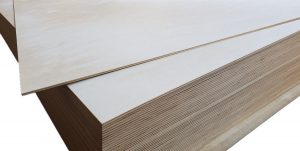Melamine mdf board is also called paint-free board, it is a decorative board formed by hot pressing, which is to lay paper with different colors or textures on particleboard, moisture-proof board, MDF, plywood, blockboard or other solid wood boards.
Craftsmanship
“Melamine”Melamine” is one of the resin adhesives used to make this kind of board. After soaking the paper with different colors or textures in the resin, it is dried to a certain degree of curing, and then it is paved on the wood board or solid wood board. The board canonical name is melamine impregnated adhesive film paper veneer wood-based board, says its melamine board is actually part of the composition of its veneer.
Melamine impregnated thermasetting resins decorative paper production process: glue making → glue dispensing (adding curing agent, release agent, etc.) → first impregnation (mixing of melamine formaldehyde resin and urea formaldehyde resin) → first drying → second impregnation (melamine formaldehyde resin)→second drying→cooling and cutting.

Material and Structure
There are mainly three types of melamine mdf in the board market: 1. Board core laminating MDF plus melamine or fire-proof paper surface paint-free board is not environmental protection, can not repeat nail, internal stress imbalance, which leads to the problem of easy deformation. 2. The paint-free board market with three plywood laminated to the core substrate is generally easy to open the glue. 3. The paint-free board with the core and the middle board and then melamine veneer or fireproof paper has high adhesiveness and strong stability, but it has extremely high requirements on the process.
The main uses
Because the melamine mdf has the characteristics of environmental protection and paint-free, it can meet the requirements of modern people for fast, environmentally friendly and convenient decoration. It can be used in cloakrooms, wall cabinets, wall decoration, ceilings, wardrobes, bookcases, tables, chairs, shoe cabinets, bathroom cabinets and other decoration furniture.
Affecting the quality of melamine mdf factors
In order to expand the use range of wood-based panel and improve the use value, it is necessary to decorate the surface. The use of melamine impregnated paper for veneer of MDF and particleboard has the advantages of less material, low energy consumption, less process, low cost and beautiful appearance. The quality problems that often occur in the production process, now analyzed as follows.
Paper Quality and Impregnation Process
In order to ensure the quality of the impregnated film paper, a high-quality decorative base paper must be tried. No matter what kind of paper, it can only be used after passing the inspection, and the unqualified cannot enter the production line. During the dipping process, the operation should be carried out in strict accordance with the technical requirements, and the sampling inspection times should be carried out every 39 minutes to ensure that the technical requirements amount of glue applied is 130%~150%, the volatile content is 6%~7%, and the degree of recalcitrance is ≤ 65%; dipping and dried adhesive film paper should be immediately packed with plastic film and sealed with adhesive tape. Store in a warehouse with a temperature of 25°C~25°C, a humidity of 55%~65%, and an air conditioner installed. Paper that cannot be used once should be sealed immediately and sent to the warehouse for storage to prevent it from absorbing moisture and causing adhesive film. Avoid they are glued together and cannot be used, causing unnecessary economic losses. In addition, damage should be avoided during the movement of the impregnated paper; if the board surface is found to be unclean during the process of forming the blank, it should be cleaned up in time; the substrate should be carefully checked.
Base material requirements for wood-based panels
Commonly used medium density fiberboard and particleboard should be manufacturering according to different requirements of customers, but particleboard products must meet the requirements of GB/T4897-92 first-class products.
1) The board surface is flat and clean, no water or oil stains are allowed. There must be no slipping edge and gnawing head defects within the effective size;
2) The thickness deviation of the board should not exceed ±0.2mm, and the sanding should be uniform, and no sand leakage defect is allowed;
3) The moisture content of the board should be controlled within the range of 6% to 10%.

